Unit 4: Leadership, Management, and Operational Strategies at Tesco
VerifiedAdded on 2020/06/05
|18
|5960
|84
Report
AI Summary
This report provides a comprehensive analysis of leadership and management within Tesco, a leading multinational retail company. It begins by defining the functions of leaders and managers, differentiating their roles in the organization, and exploring their impact on achieving business objectives. The report then delves into the application of leadership and managerial roles in Tesco, examining how they contribute to operational efficiency and strategic planning. It further investigates various leadership theories and models, such as contingency theory, situational leadership, and transactional/transformational leadership, assessing their strengths and weaknesses in the context of Tesco's operations. The report also examines the importance of operational management in achieving business goals, highlighting its value in Tesco's success. Finally, it analyzes the factors within the business environment that influence decision-making and operational management, providing a critical evaluation of management application within the company. The report concludes with a summary of the key findings and insights gained from the analysis.
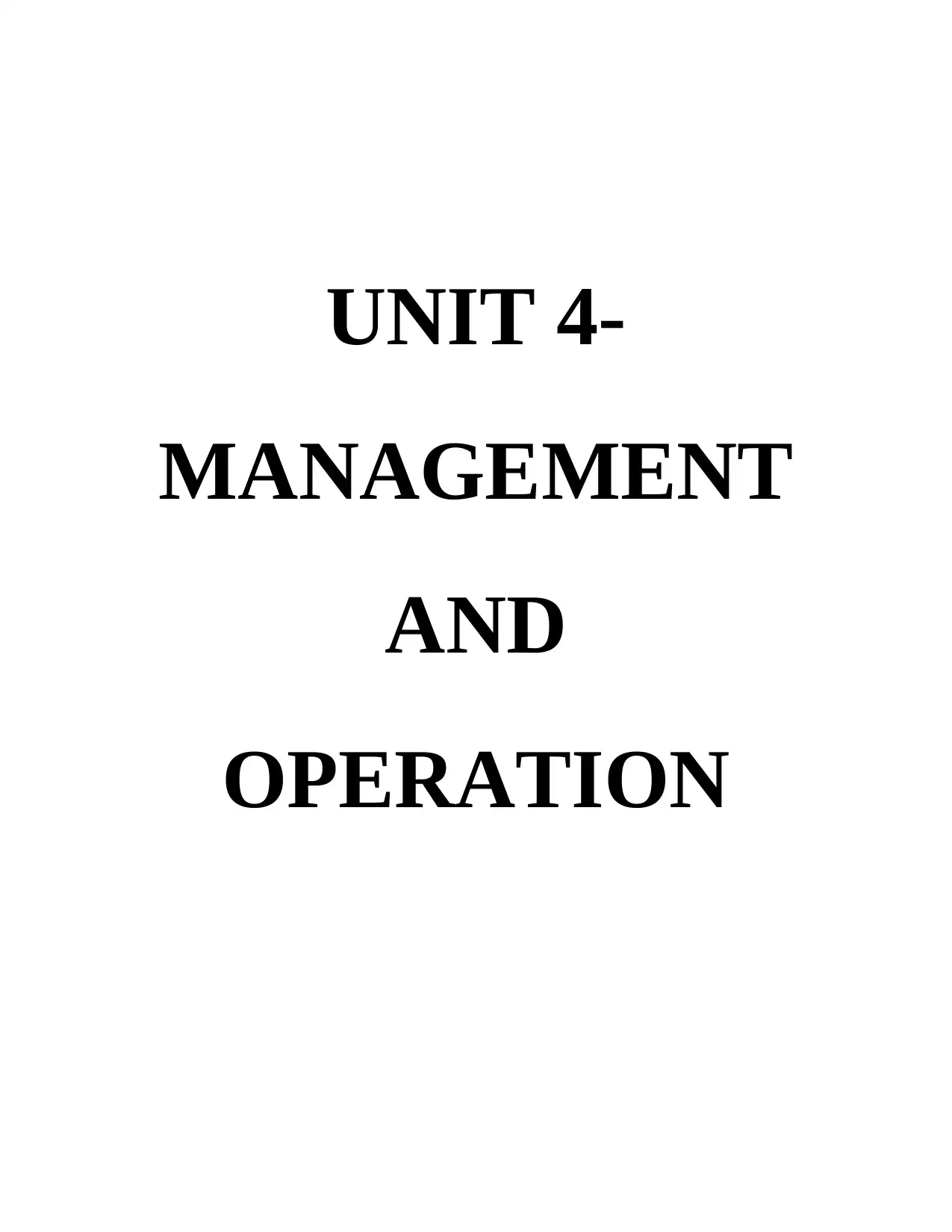
UNIT 4-
MANAGEMENT
AND
OPERATION
MANAGEMENT
AND
OPERATION
Paraphrase This Document
Need a fresh take? Get an instant paraphrase of this document with our AI Paraphraser
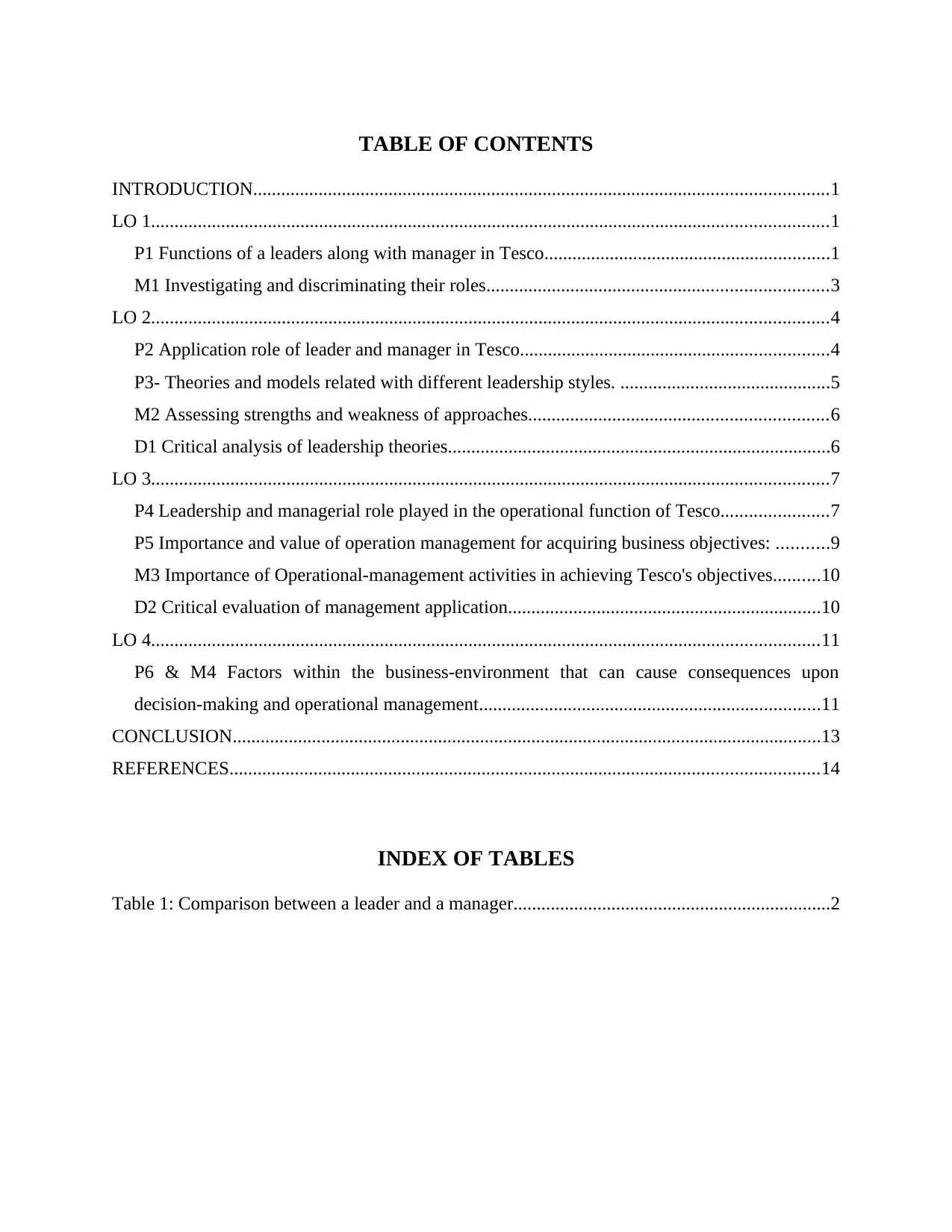
TABLE OF CONTENTS
INTRODUCTION...........................................................................................................................1
LO 1.................................................................................................................................................1
P1 Functions of a leaders along with manager in Tesco.............................................................1
M1 Investigating and discriminating their roles.........................................................................3
LO 2.................................................................................................................................................4
P2 Application role of leader and manager in Tesco..................................................................4
P3- Theories and models related with different leadership styles. .............................................5
M2 Assessing strengths and weakness of approaches................................................................6
D1 Critical analysis of leadership theories..................................................................................6
LO 3.................................................................................................................................................7
P4 Leadership and managerial role played in the operational function of Tesco.......................7
P5 Importance and value of operation management for acquiring business objectives: ...........9
M3 Importance of Operational-management activities in achieving Tesco's objectives..........10
D2 Critical evaluation of management application...................................................................10
LO 4...............................................................................................................................................11
P6 & M4 Factors within the business-environment that can cause consequences upon
decision-making and operational management.........................................................................11
CONCLUSION..............................................................................................................................13
REFERENCES..............................................................................................................................14
INDEX OF TABLES
Table 1: Comparison between a leader and a manager....................................................................2
INTRODUCTION...........................................................................................................................1
LO 1.................................................................................................................................................1
P1 Functions of a leaders along with manager in Tesco.............................................................1
M1 Investigating and discriminating their roles.........................................................................3
LO 2.................................................................................................................................................4
P2 Application role of leader and manager in Tesco..................................................................4
P3- Theories and models related with different leadership styles. .............................................5
M2 Assessing strengths and weakness of approaches................................................................6
D1 Critical analysis of leadership theories..................................................................................6
LO 3.................................................................................................................................................7
P4 Leadership and managerial role played in the operational function of Tesco.......................7
P5 Importance and value of operation management for acquiring business objectives: ...........9
M3 Importance of Operational-management activities in achieving Tesco's objectives..........10
D2 Critical evaluation of management application...................................................................10
LO 4...............................................................................................................................................11
P6 & M4 Factors within the business-environment that can cause consequences upon
decision-making and operational management.........................................................................11
CONCLUSION..............................................................................................................................13
REFERENCES..............................................................................................................................14
INDEX OF TABLES
Table 1: Comparison between a leader and a manager....................................................................2
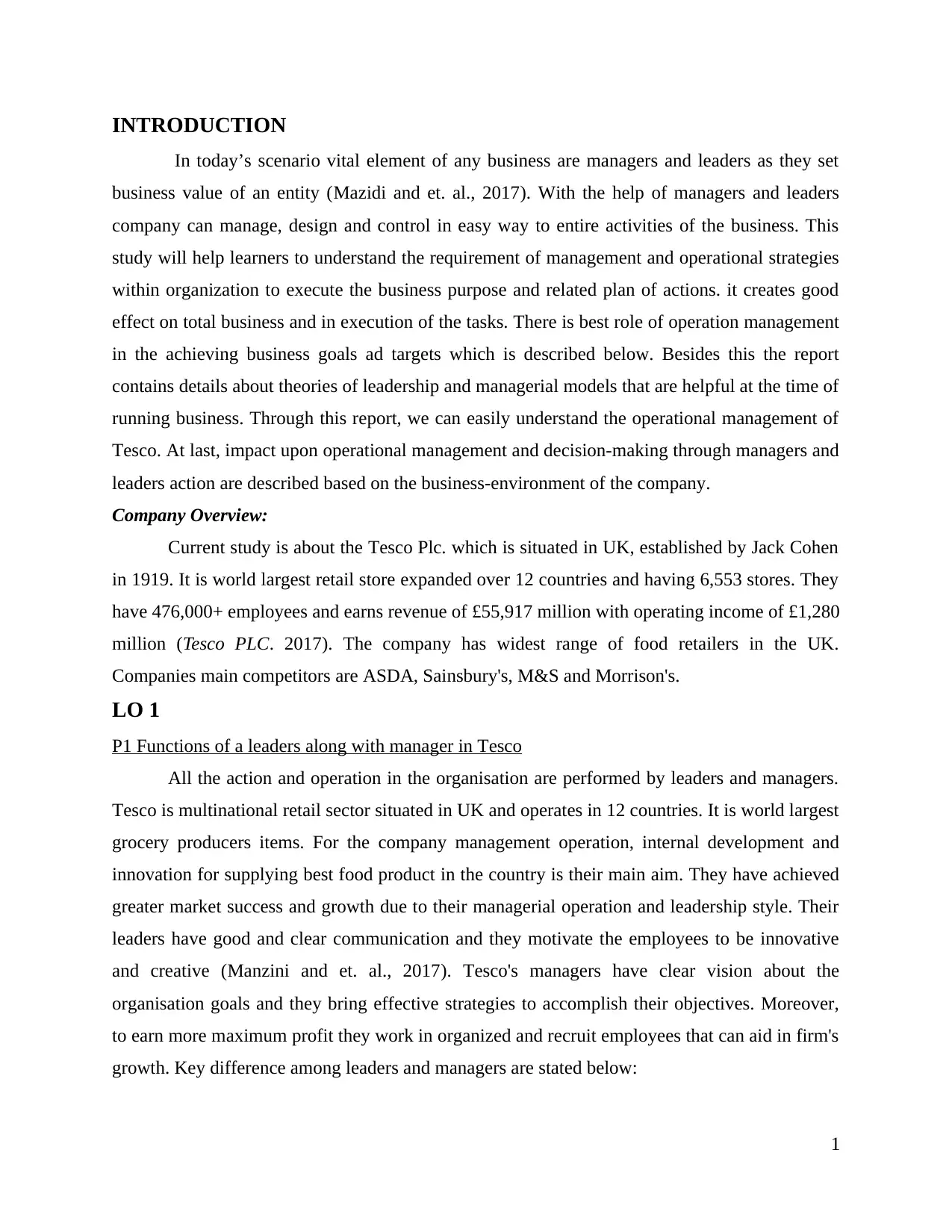
INTRODUCTION
In today’s scenario vital element of any business are managers and leaders as they set
business value of an entity (Mazidi and et. al., 2017). With the help of managers and leaders
company can manage, design and control in easy way to entire activities of the business. This
study will help learners to understand the requirement of management and operational strategies
within organization to execute the business purpose and related plan of actions. it creates good
effect on total business and in execution of the tasks. There is best role of operation management
in the achieving business goals ad targets which is described below. Besides this the report
contains details about theories of leadership and managerial models that are helpful at the time of
running business. Through this report, we can easily understand the operational management of
Tesco. At last, impact upon operational management and decision-making through managers and
leaders action are described based on the business-environment of the company.
Company Overview:
Current study is about the Tesco Plc. which is situated in UK, established by Jack Cohen
in 1919. It is world largest retail store expanded over 12 countries and having 6,553 stores. They
have 476,000+ employees and earns revenue of £55,917 million with operating income of £1,280
million (Tesco PLC. 2017). The company has widest range of food retailers in the UK.
Companies main competitors are ASDA, Sainsbury's, M&S and Morrison's.
LO 1
P1 Functions of a leaders along with manager in Tesco
All the action and operation in the organisation are performed by leaders and managers.
Tesco is multinational retail sector situated in UK and operates in 12 countries. It is world largest
grocery producers items. For the company management operation, internal development and
innovation for supplying best food product in the country is their main aim. They have achieved
greater market success and growth due to their managerial operation and leadership style. Their
leaders have good and clear communication and they motivate the employees to be innovative
and creative (Manzini and et. al., 2017). Tesco's managers have clear vision about the
organisation goals and they bring effective strategies to accomplish their objectives. Moreover,
to earn more maximum profit they work in organized and recruit employees that can aid in firm's
growth. Key difference among leaders and managers are stated below:
1
In today’s scenario vital element of any business are managers and leaders as they set
business value of an entity (Mazidi and et. al., 2017). With the help of managers and leaders
company can manage, design and control in easy way to entire activities of the business. This
study will help learners to understand the requirement of management and operational strategies
within organization to execute the business purpose and related plan of actions. it creates good
effect on total business and in execution of the tasks. There is best role of operation management
in the achieving business goals ad targets which is described below. Besides this the report
contains details about theories of leadership and managerial models that are helpful at the time of
running business. Through this report, we can easily understand the operational management of
Tesco. At last, impact upon operational management and decision-making through managers and
leaders action are described based on the business-environment of the company.
Company Overview:
Current study is about the Tesco Plc. which is situated in UK, established by Jack Cohen
in 1919. It is world largest retail store expanded over 12 countries and having 6,553 stores. They
have 476,000+ employees and earns revenue of £55,917 million with operating income of £1,280
million (Tesco PLC. 2017). The company has widest range of food retailers in the UK.
Companies main competitors are ASDA, Sainsbury's, M&S and Morrison's.
LO 1
P1 Functions of a leaders along with manager in Tesco
All the action and operation in the organisation are performed by leaders and managers.
Tesco is multinational retail sector situated in UK and operates in 12 countries. It is world largest
grocery producers items. For the company management operation, internal development and
innovation for supplying best food product in the country is their main aim. They have achieved
greater market success and growth due to their managerial operation and leadership style. Their
leaders have good and clear communication and they motivate the employees to be innovative
and creative (Manzini and et. al., 2017). Tesco's managers have clear vision about the
organisation goals and they bring effective strategies to accomplish their objectives. Moreover,
to earn more maximum profit they work in organized and recruit employees that can aid in firm's
growth. Key difference among leaders and managers are stated below:
1
⊘ This is a preview!⊘
Do you want full access?
Subscribe today to unlock all pages.

Trusted by 1+ million students worldwide
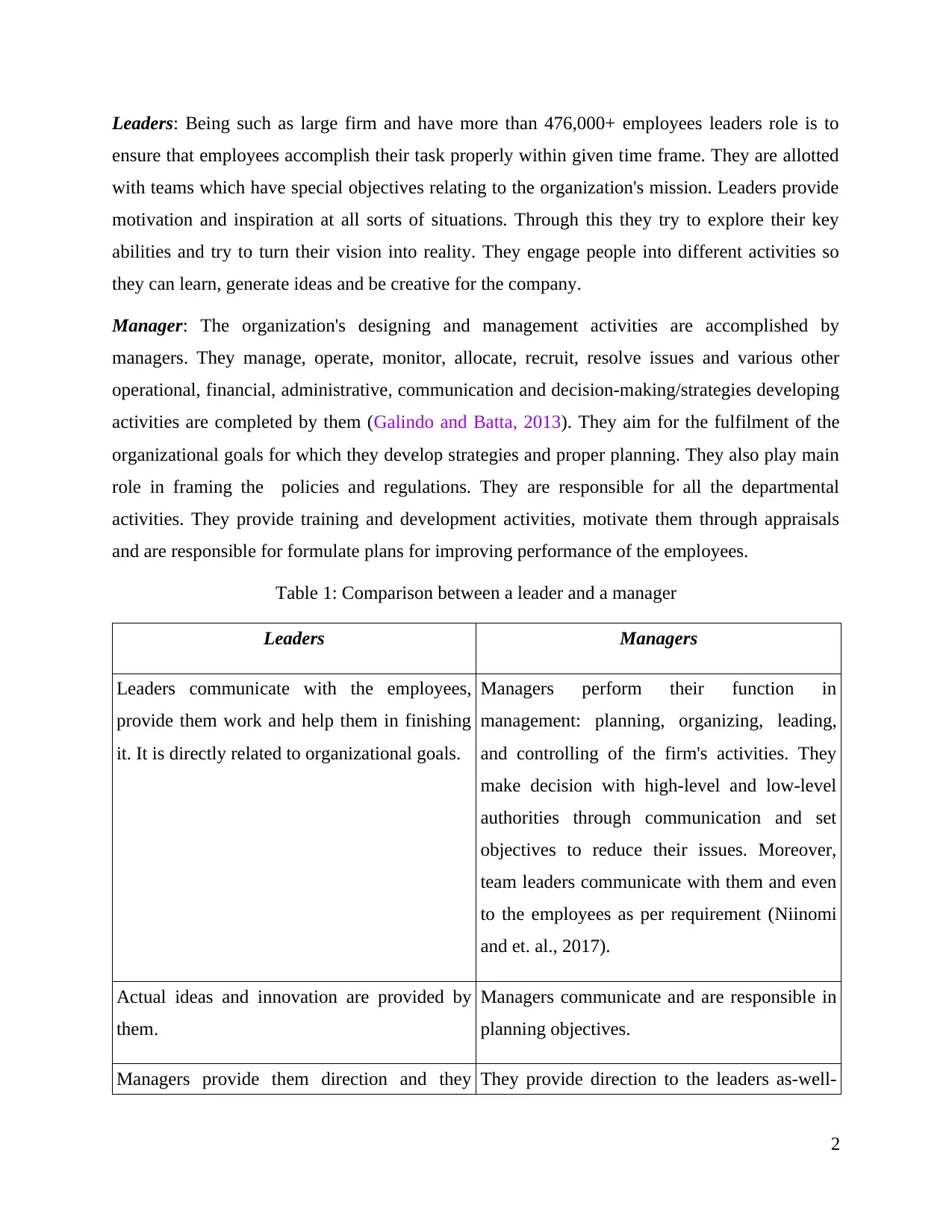
Leaders: Being such as large firm and have more than 476,000+ employees leaders role is to
ensure that employees accomplish their task properly within given time frame. They are allotted
with teams which have special objectives relating to the organization's mission. Leaders provide
motivation and inspiration at all sorts of situations. Through this they try to explore their key
abilities and try to turn their vision into reality. They engage people into different activities so
they can learn, generate ideas and be creative for the company.
Manager: The organization's designing and management activities are accomplished by
managers. They manage, operate, monitor, allocate, recruit, resolve issues and various other
operational, financial, administrative, communication and decision-making/strategies developing
activities are completed by them (Galindo and Batta, 2013). They aim for the fulfilment of the
organizational goals for which they develop strategies and proper planning. They also play main
role in framing the policies and regulations. They are responsible for all the departmental
activities. They provide training and development activities, motivate them through appraisals
and are responsible for formulate plans for improving performance of the employees.
Table 1: Comparison between a leader and a manager
Leaders Managers
Leaders communicate with the employees,
provide them work and help them in finishing
it. It is directly related to organizational goals.
Managers perform their function in
management: planning, organizing, leading,
and controlling of the firm's activities. They
make decision with high-level and low-level
authorities through communication and set
objectives to reduce their issues. Moreover,
team leaders communicate with them and even
to the employees as per requirement (Niinomi
and et. al., 2017).
Actual ideas and innovation are provided by
them.
Managers communicate and are responsible in
planning objectives.
Managers provide them direction and they They provide direction to the leaders as-well-
2
ensure that employees accomplish their task properly within given time frame. They are allotted
with teams which have special objectives relating to the organization's mission. Leaders provide
motivation and inspiration at all sorts of situations. Through this they try to explore their key
abilities and try to turn their vision into reality. They engage people into different activities so
they can learn, generate ideas and be creative for the company.
Manager: The organization's designing and management activities are accomplished by
managers. They manage, operate, monitor, allocate, recruit, resolve issues and various other
operational, financial, administrative, communication and decision-making/strategies developing
activities are completed by them (Galindo and Batta, 2013). They aim for the fulfilment of the
organizational goals for which they develop strategies and proper planning. They also play main
role in framing the policies and regulations. They are responsible for all the departmental
activities. They provide training and development activities, motivate them through appraisals
and are responsible for formulate plans for improving performance of the employees.
Table 1: Comparison between a leader and a manager
Leaders Managers
Leaders communicate with the employees,
provide them work and help them in finishing
it. It is directly related to organizational goals.
Managers perform their function in
management: planning, organizing, leading,
and controlling of the firm's activities. They
make decision with high-level and low-level
authorities through communication and set
objectives to reduce their issues. Moreover,
team leaders communicate with them and even
to the employees as per requirement (Niinomi
and et. al., 2017).
Actual ideas and innovation are provided by
them.
Managers communicate and are responsible in
planning objectives.
Managers provide them direction and they They provide direction to the leaders as-well-
2
Paraphrase This Document
Need a fresh take? Get an instant paraphrase of this document with our AI Paraphraser
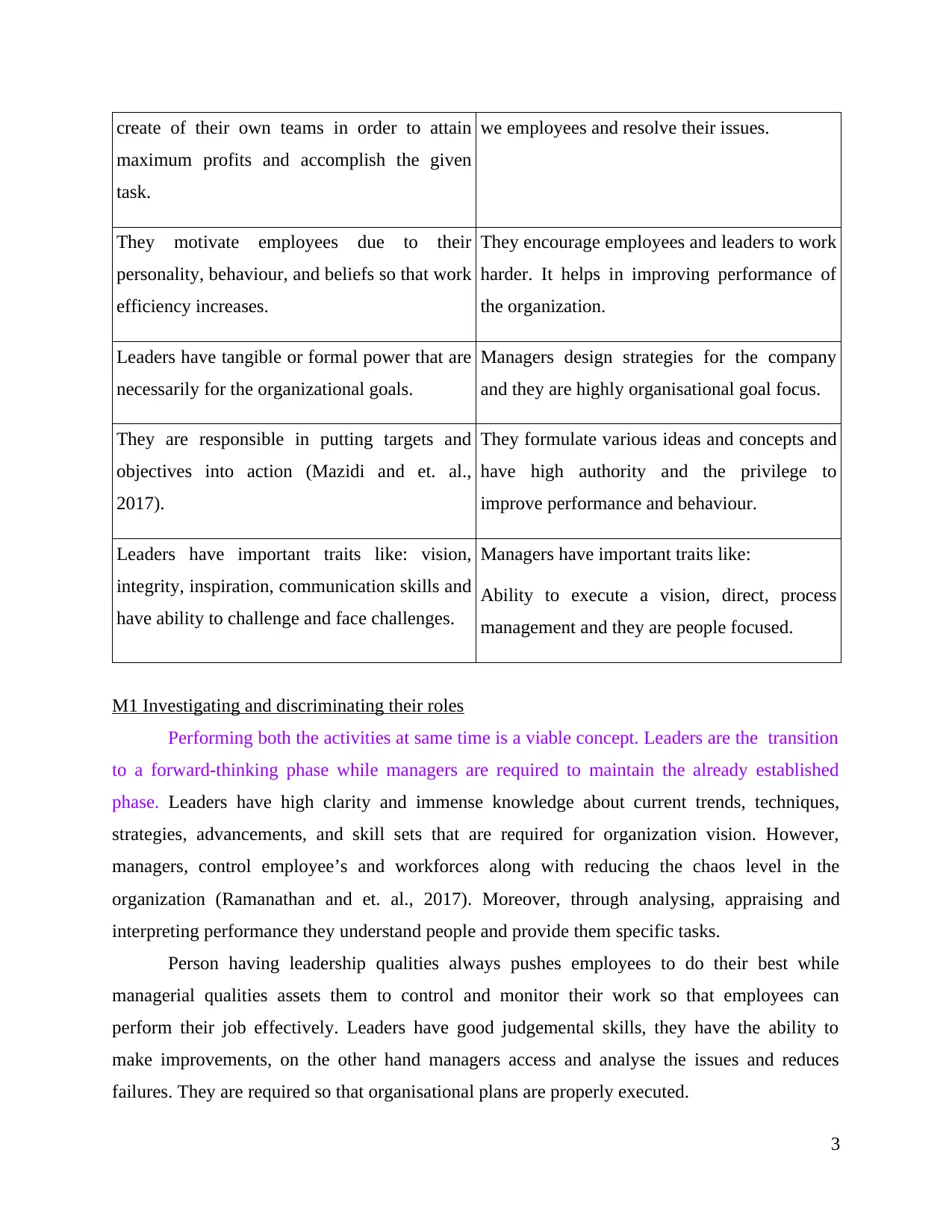
create of their own teams in order to attain
maximum profits and accomplish the given
task.
we employees and resolve their issues.
They motivate employees due to their
personality, behaviour, and beliefs so that work
efficiency increases.
They encourage employees and leaders to work
harder. It helps in improving performance of
the organization.
Leaders have tangible or formal power that are
necessarily for the organizational goals.
Managers design strategies for the company
and they are highly organisational goal focus.
They are responsible in putting targets and
objectives into action (Mazidi and et. al.,
2017).
They formulate various ideas and concepts and
have high authority and the privilege to
improve performance and behaviour.
Leaders have important traits like: vision,
integrity, inspiration, communication skills and
have ability to challenge and face challenges.
Managers have important traits like:
Ability to execute a vision, direct, process
management and they are people focused.
M1 Investigating and discriminating their roles
Performing both the activities at same time is a viable concept. Leaders are the transition
to a forward-thinking phase while managers are required to maintain the already established
phase. Leaders have high clarity and immense knowledge about current trends, techniques,
strategies, advancements, and skill sets that are required for organization vision. However,
managers, control employee’s and workforces along with reducing the chaos level in the
organization (Ramanathan and et. al., 2017). Moreover, through analysing, appraising and
interpreting performance they understand people and provide them specific tasks.
Person having leadership qualities always pushes employees to do their best while
managerial qualities assets them to control and monitor their work so that employees can
perform their job effectively. Leaders have good judgemental skills, they have the ability to
make improvements, on the other hand managers access and analyse the issues and reduces
failures. They are required so that organisational plans are properly executed.
3
maximum profits and accomplish the given
task.
we employees and resolve their issues.
They motivate employees due to their
personality, behaviour, and beliefs so that work
efficiency increases.
They encourage employees and leaders to work
harder. It helps in improving performance of
the organization.
Leaders have tangible or formal power that are
necessarily for the organizational goals.
Managers design strategies for the company
and they are highly organisational goal focus.
They are responsible in putting targets and
objectives into action (Mazidi and et. al.,
2017).
They formulate various ideas and concepts and
have high authority and the privilege to
improve performance and behaviour.
Leaders have important traits like: vision,
integrity, inspiration, communication skills and
have ability to challenge and face challenges.
Managers have important traits like:
Ability to execute a vision, direct, process
management and they are people focused.
M1 Investigating and discriminating their roles
Performing both the activities at same time is a viable concept. Leaders are the transition
to a forward-thinking phase while managers are required to maintain the already established
phase. Leaders have high clarity and immense knowledge about current trends, techniques,
strategies, advancements, and skill sets that are required for organization vision. However,
managers, control employee’s and workforces along with reducing the chaos level in the
organization (Ramanathan and et. al., 2017). Moreover, through analysing, appraising and
interpreting performance they understand people and provide them specific tasks.
Person having leadership qualities always pushes employees to do their best while
managerial qualities assets them to control and monitor their work so that employees can
perform their job effectively. Leaders have good judgemental skills, they have the ability to
make improvements, on the other hand managers access and analyse the issues and reduces
failures. They are required so that organisational plans are properly executed.
3
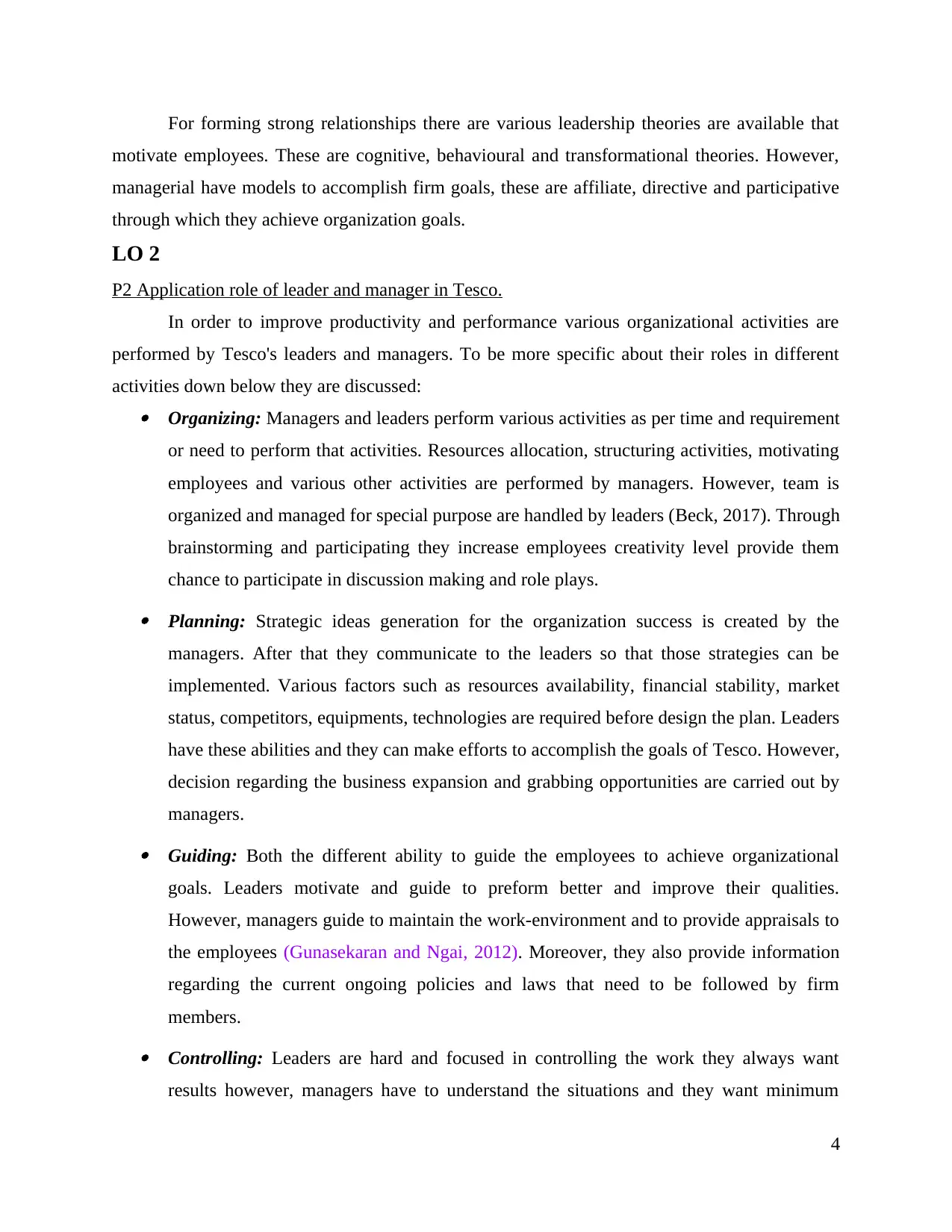
For forming strong relationships there are various leadership theories are available that
motivate employees. These are cognitive, behavioural and transformational theories. However,
managerial have models to accomplish firm goals, these are affiliate, directive and participative
through which they achieve organization goals.
LO 2
P2 Application role of leader and manager in Tesco.
In order to improve productivity and performance various organizational activities are
performed by Tesco's leaders and managers. To be more specific about their roles in different
activities down below they are discussed: Organizing: Managers and leaders perform various activities as per time and requirement
or need to perform that activities. Resources allocation, structuring activities, motivating
employees and various other activities are performed by managers. However, team is
organized and managed for special purpose are handled by leaders (Beck, 2017). Through
brainstorming and participating they increase employees creativity level provide them
chance to participate in discussion making and role plays. Planning: Strategic ideas generation for the organization success is created by the
managers. After that they communicate to the leaders so that those strategies can be
implemented. Various factors such as resources availability, financial stability, market
status, competitors, equipments, technologies are required before design the plan. Leaders
have these abilities and they can make efforts to accomplish the goals of Tesco. However,
decision regarding the business expansion and grabbing opportunities are carried out by
managers. Guiding: Both the different ability to guide the employees to achieve organizational
goals. Leaders motivate and guide to preform better and improve their qualities.
However, managers guide to maintain the work-environment and to provide appraisals to
the employees (Gunasekaran and Ngai, 2012). Moreover, they also provide information
regarding the current ongoing policies and laws that need to be followed by firm
members. Controlling: Leaders are hard and focused in controlling the work they always want
results however, managers have to understand the situations and they want minimum
4
motivate employees. These are cognitive, behavioural and transformational theories. However,
managerial have models to accomplish firm goals, these are affiliate, directive and participative
through which they achieve organization goals.
LO 2
P2 Application role of leader and manager in Tesco.
In order to improve productivity and performance various organizational activities are
performed by Tesco's leaders and managers. To be more specific about their roles in different
activities down below they are discussed: Organizing: Managers and leaders perform various activities as per time and requirement
or need to perform that activities. Resources allocation, structuring activities, motivating
employees and various other activities are performed by managers. However, team is
organized and managed for special purpose are handled by leaders (Beck, 2017). Through
brainstorming and participating they increase employees creativity level provide them
chance to participate in discussion making and role plays. Planning: Strategic ideas generation for the organization success is created by the
managers. After that they communicate to the leaders so that those strategies can be
implemented. Various factors such as resources availability, financial stability, market
status, competitors, equipments, technologies are required before design the plan. Leaders
have these abilities and they can make efforts to accomplish the goals of Tesco. However,
decision regarding the business expansion and grabbing opportunities are carried out by
managers. Guiding: Both the different ability to guide the employees to achieve organizational
goals. Leaders motivate and guide to preform better and improve their qualities.
However, managers guide to maintain the work-environment and to provide appraisals to
the employees (Gunasekaran and Ngai, 2012). Moreover, they also provide information
regarding the current ongoing policies and laws that need to be followed by firm
members. Controlling: Leaders are hard and focused in controlling the work they always want
results however, managers have to understand the situations and they want minimum
4
⊘ This is a preview!⊘
Do you want full access?
Subscribe today to unlock all pages.

Trusted by 1+ million students worldwide
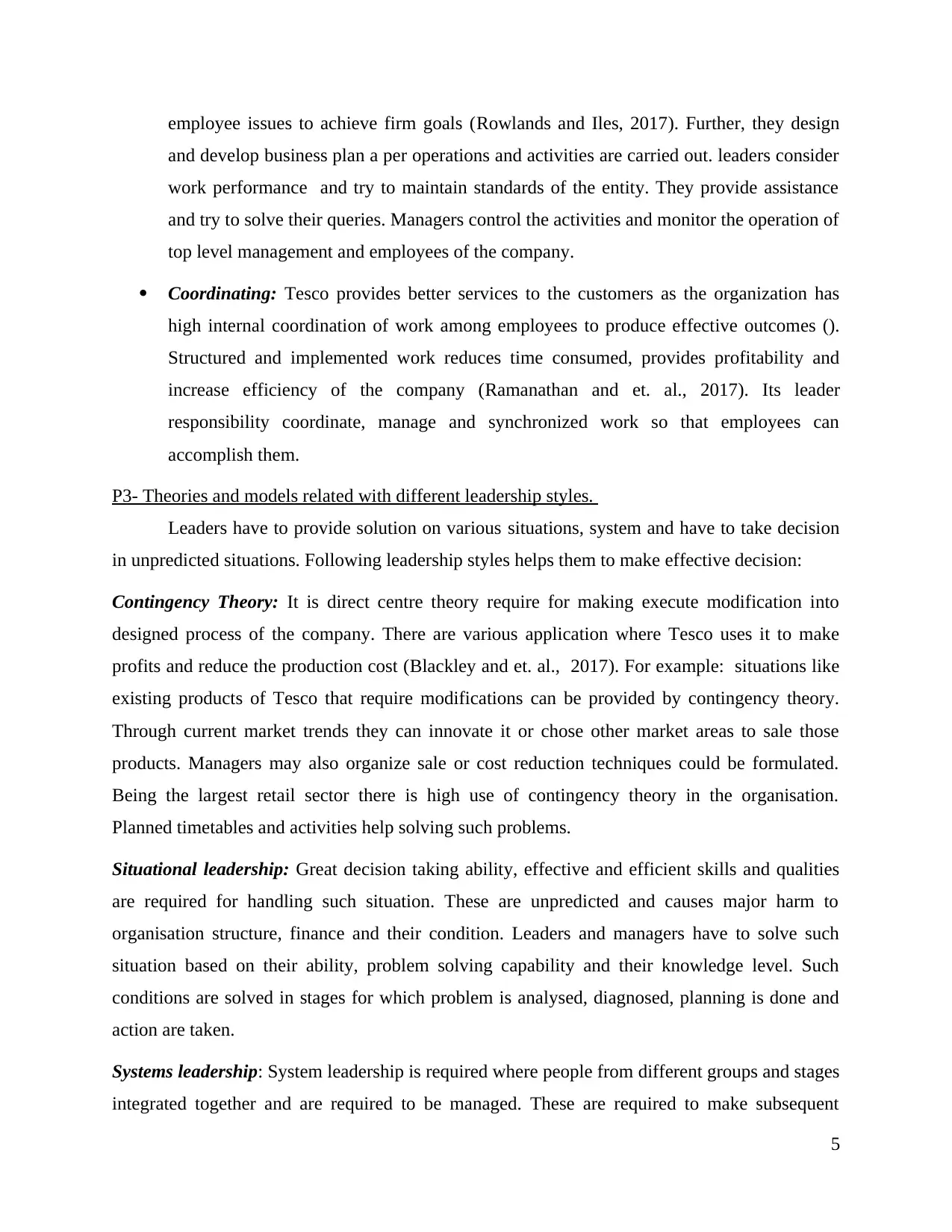
employee issues to achieve firm goals (Rowlands and Iles, 2017). Further, they design
and develop business plan a per operations and activities are carried out. leaders consider
work performance and try to maintain standards of the entity. They provide assistance
and try to solve their queries. Managers control the activities and monitor the operation of
top level management and employees of the company.
Coordinating: Tesco provides better services to the customers as the organization has
high internal coordination of work among employees to produce effective outcomes ().
Structured and implemented work reduces time consumed, provides profitability and
increase efficiency of the company (Ramanathan and et. al., 2017). Its leader
responsibility coordinate, manage and synchronized work so that employees can
accomplish them.
P3- Theories and models related with different leadership styles.
Leaders have to provide solution on various situations, system and have to take decision
in unpredicted situations. Following leadership styles helps them to make effective decision:
Contingency Theory: It is direct centre theory require for making execute modification into
designed process of the company. There are various application where Tesco uses it to make
profits and reduce the production cost (Blackley and et. al., 2017). For example: situations like
existing products of Tesco that require modifications can be provided by contingency theory.
Through current market trends they can innovate it or chose other market areas to sale those
products. Managers may also organize sale or cost reduction techniques could be formulated.
Being the largest retail sector there is high use of contingency theory in the organisation.
Planned timetables and activities help solving such problems.
Situational leadership: Great decision taking ability, effective and efficient skills and qualities
are required for handling such situation. These are unpredicted and causes major harm to
organisation structure, finance and their condition. Leaders and managers have to solve such
situation based on their ability, problem solving capability and their knowledge level. Such
conditions are solved in stages for which problem is analysed, diagnosed, planning is done and
action are taken.
Systems leadership: System leadership is required where people from different groups and stages
integrated together and are required to be managed. These are required to make subsequent
5
and develop business plan a per operations and activities are carried out. leaders consider
work performance and try to maintain standards of the entity. They provide assistance
and try to solve their queries. Managers control the activities and monitor the operation of
top level management and employees of the company.
Coordinating: Tesco provides better services to the customers as the organization has
high internal coordination of work among employees to produce effective outcomes ().
Structured and implemented work reduces time consumed, provides profitability and
increase efficiency of the company (Ramanathan and et. al., 2017). Its leader
responsibility coordinate, manage and synchronized work so that employees can
accomplish them.
P3- Theories and models related with different leadership styles.
Leaders have to provide solution on various situations, system and have to take decision
in unpredicted situations. Following leadership styles helps them to make effective decision:
Contingency Theory: It is direct centre theory require for making execute modification into
designed process of the company. There are various application where Tesco uses it to make
profits and reduce the production cost (Blackley and et. al., 2017). For example: situations like
existing products of Tesco that require modifications can be provided by contingency theory.
Through current market trends they can innovate it or chose other market areas to sale those
products. Managers may also organize sale or cost reduction techniques could be formulated.
Being the largest retail sector there is high use of contingency theory in the organisation.
Planned timetables and activities help solving such problems.
Situational leadership: Great decision taking ability, effective and efficient skills and qualities
are required for handling such situation. These are unpredicted and causes major harm to
organisation structure, finance and their condition. Leaders and managers have to solve such
situation based on their ability, problem solving capability and their knowledge level. Such
conditions are solved in stages for which problem is analysed, diagnosed, planning is done and
action are taken.
Systems leadership: System leadership is required where people from different groups and stages
integrated together and are required to be managed. These are required to make subsequent
5
Paraphrase This Document
Need a fresh take? Get an instant paraphrase of this document with our AI Paraphraser
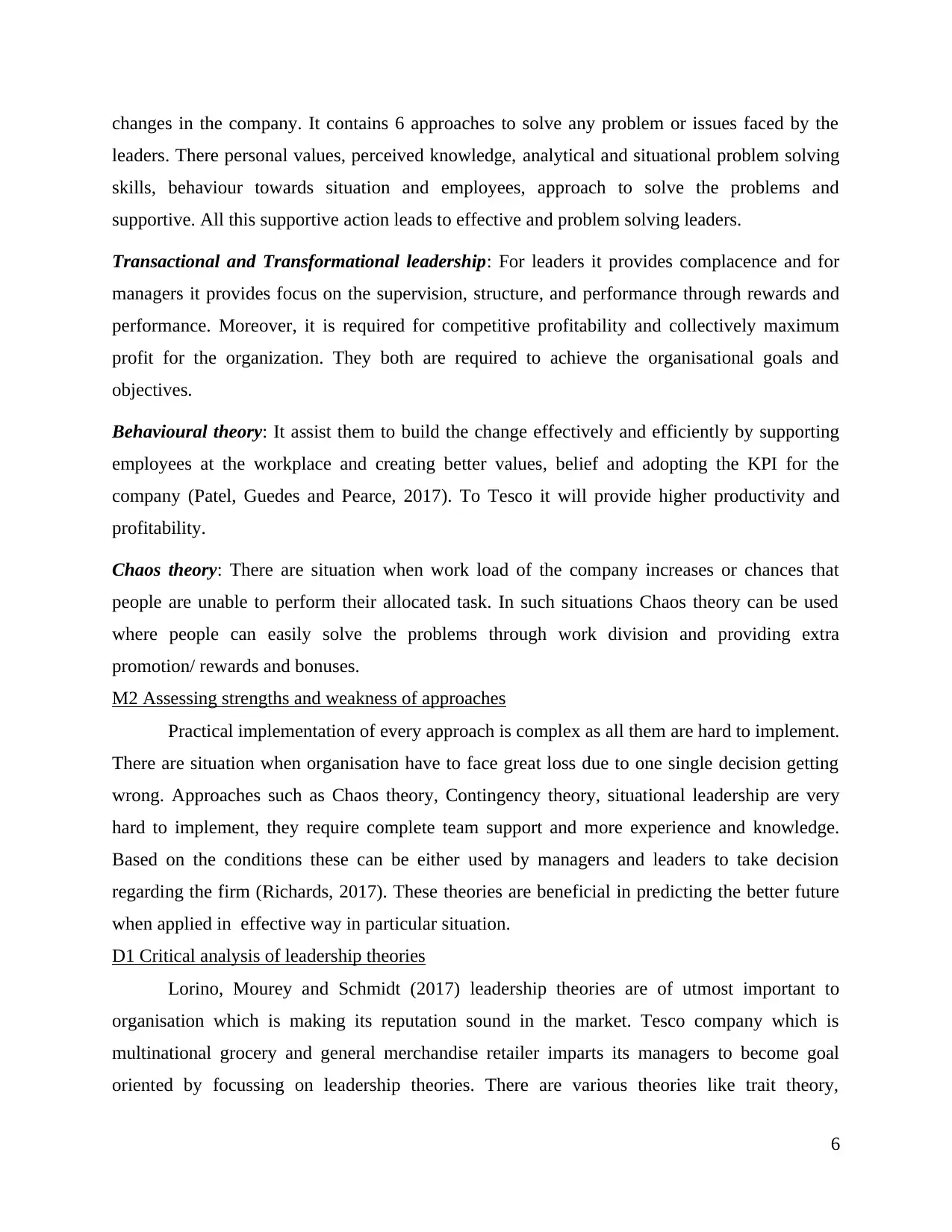
changes in the company. It contains 6 approaches to solve any problem or issues faced by the
leaders. There personal values, perceived knowledge, analytical and situational problem solving
skills, behaviour towards situation and employees, approach to solve the problems and
supportive. All this supportive action leads to effective and problem solving leaders.
Transactional and Transformational leadership: For leaders it provides complacence and for
managers it provides focus on the supervision, structure, and performance through rewards and
performance. Moreover, it is required for competitive profitability and collectively maximum
profit for the organization. They both are required to achieve the organisational goals and
objectives.
Behavioural theory: It assist them to build the change effectively and efficiently by supporting
employees at the workplace and creating better values, belief and adopting the KPI for the
company (Patel, Guedes and Pearce, 2017). To Tesco it will provide higher productivity and
profitability.
Chaos theory: There are situation when work load of the company increases or chances that
people are unable to perform their allocated task. In such situations Chaos theory can be used
where people can easily solve the problems through work division and providing extra
promotion/ rewards and bonuses.
M2 Assessing strengths and weakness of approaches
Practical implementation of every approach is complex as all them are hard to implement.
There are situation when organisation have to face great loss due to one single decision getting
wrong. Approaches such as Chaos theory, Contingency theory, situational leadership are very
hard to implement, they require complete team support and more experience and knowledge.
Based on the conditions these can be either used by managers and leaders to take decision
regarding the firm (Richards, 2017). These theories are beneficial in predicting the better future
when applied in effective way in particular situation.
D1 Critical analysis of leadership theories
Lorino, Mourey and Schmidt (2017) leadership theories are of utmost important to
organisation which is making its reputation sound in the market. Tesco company which is
multinational grocery and general merchandise retailer imparts its managers to become goal
oriented by focussing on leadership theories. There are various theories like trait theory,
6
leaders. There personal values, perceived knowledge, analytical and situational problem solving
skills, behaviour towards situation and employees, approach to solve the problems and
supportive. All this supportive action leads to effective and problem solving leaders.
Transactional and Transformational leadership: For leaders it provides complacence and for
managers it provides focus on the supervision, structure, and performance through rewards and
performance. Moreover, it is required for competitive profitability and collectively maximum
profit for the organization. They both are required to achieve the organisational goals and
objectives.
Behavioural theory: It assist them to build the change effectively and efficiently by supporting
employees at the workplace and creating better values, belief and adopting the KPI for the
company (Patel, Guedes and Pearce, 2017). To Tesco it will provide higher productivity and
profitability.
Chaos theory: There are situation when work load of the company increases or chances that
people are unable to perform their allocated task. In such situations Chaos theory can be used
where people can easily solve the problems through work division and providing extra
promotion/ rewards and bonuses.
M2 Assessing strengths and weakness of approaches
Practical implementation of every approach is complex as all them are hard to implement.
There are situation when organisation have to face great loss due to one single decision getting
wrong. Approaches such as Chaos theory, Contingency theory, situational leadership are very
hard to implement, they require complete team support and more experience and knowledge.
Based on the conditions these can be either used by managers and leaders to take decision
regarding the firm (Richards, 2017). These theories are beneficial in predicting the better future
when applied in effective way in particular situation.
D1 Critical analysis of leadership theories
Lorino, Mourey and Schmidt (2017) leadership theories are of utmost important to
organisation which is making its reputation sound in the market. Tesco company which is
multinational grocery and general merchandise retailer imparts its managers to become goal
oriented by focussing on leadership theories. There are various theories like trait theory,
6
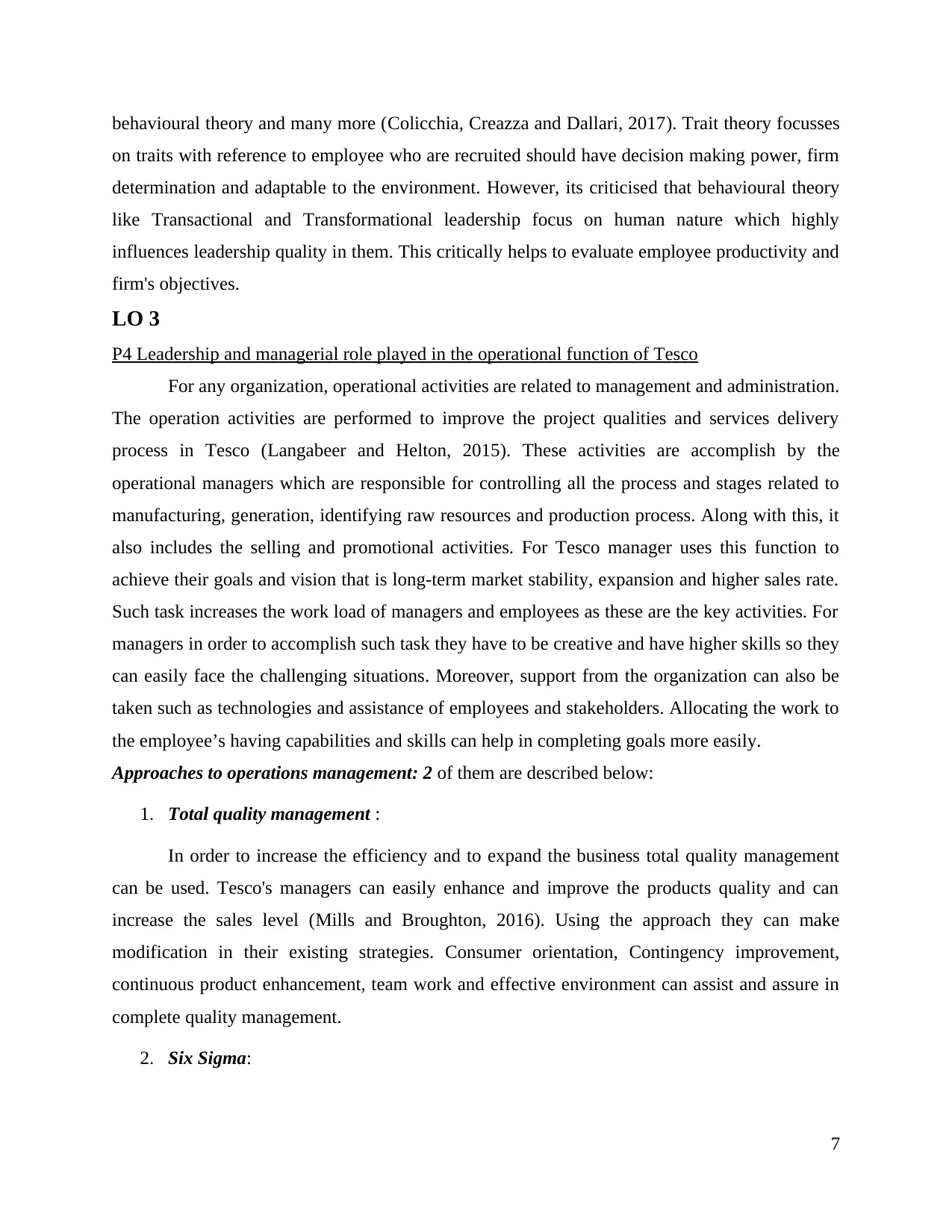
behavioural theory and many more (Colicchia, Creazza and Dallari, 2017). Trait theory focusses
on traits with reference to employee who are recruited should have decision making power, firm
determination and adaptable to the environment. However, its criticised that behavioural theory
like Transactional and Transformational leadership focus on human nature which highly
influences leadership quality in them. This critically helps to evaluate employee productivity and
firm's objectives.
LO 3
P4 Leadership and managerial role played in the operational function of Tesco
For any organization, operational activities are related to management and administration.
The operation activities are performed to improve the project qualities and services delivery
process in Tesco (Langabeer and Helton, 2015). These activities are accomplish by the
operational managers which are responsible for controlling all the process and stages related to
manufacturing, generation, identifying raw resources and production process. Along with this, it
also includes the selling and promotional activities. For Tesco manager uses this function to
achieve their goals and vision that is long-term market stability, expansion and higher sales rate.
Such task increases the work load of managers and employees as these are the key activities. For
managers in order to accomplish such task they have to be creative and have higher skills so they
can easily face the challenging situations. Moreover, support from the organization can also be
taken such as technologies and assistance of employees and stakeholders. Allocating the work to
the employee’s having capabilities and skills can help in completing goals more easily.
Approaches to operations management: 2 of them are described below:
1. Total quality management :
In order to increase the efficiency and to expand the business total quality management
can be used. Tesco's managers can easily enhance and improve the products quality and can
increase the sales level (Mills and Broughton, 2016). Using the approach they can make
modification in their existing strategies. Consumer orientation, Contingency improvement,
continuous product enhancement, team work and effective environment can assist and assure in
complete quality management.
2. Six Sigma:
7
on traits with reference to employee who are recruited should have decision making power, firm
determination and adaptable to the environment. However, its criticised that behavioural theory
like Transactional and Transformational leadership focus on human nature which highly
influences leadership quality in them. This critically helps to evaluate employee productivity and
firm's objectives.
LO 3
P4 Leadership and managerial role played in the operational function of Tesco
For any organization, operational activities are related to management and administration.
The operation activities are performed to improve the project qualities and services delivery
process in Tesco (Langabeer and Helton, 2015). These activities are accomplish by the
operational managers which are responsible for controlling all the process and stages related to
manufacturing, generation, identifying raw resources and production process. Along with this, it
also includes the selling and promotional activities. For Tesco manager uses this function to
achieve their goals and vision that is long-term market stability, expansion and higher sales rate.
Such task increases the work load of managers and employees as these are the key activities. For
managers in order to accomplish such task they have to be creative and have higher skills so they
can easily face the challenging situations. Moreover, support from the organization can also be
taken such as technologies and assistance of employees and stakeholders. Allocating the work to
the employee’s having capabilities and skills can help in completing goals more easily.
Approaches to operations management: 2 of them are described below:
1. Total quality management :
In order to increase the efficiency and to expand the business total quality management
can be used. Tesco's managers can easily enhance and improve the products quality and can
increase the sales level (Mills and Broughton, 2016). Using the approach they can make
modification in their existing strategies. Consumer orientation, Contingency improvement,
continuous product enhancement, team work and effective environment can assist and assure in
complete quality management.
2. Six Sigma:
7
⊘ This is a preview!⊘
Do you want full access?
Subscribe today to unlock all pages.

Trusted by 1+ million students worldwide
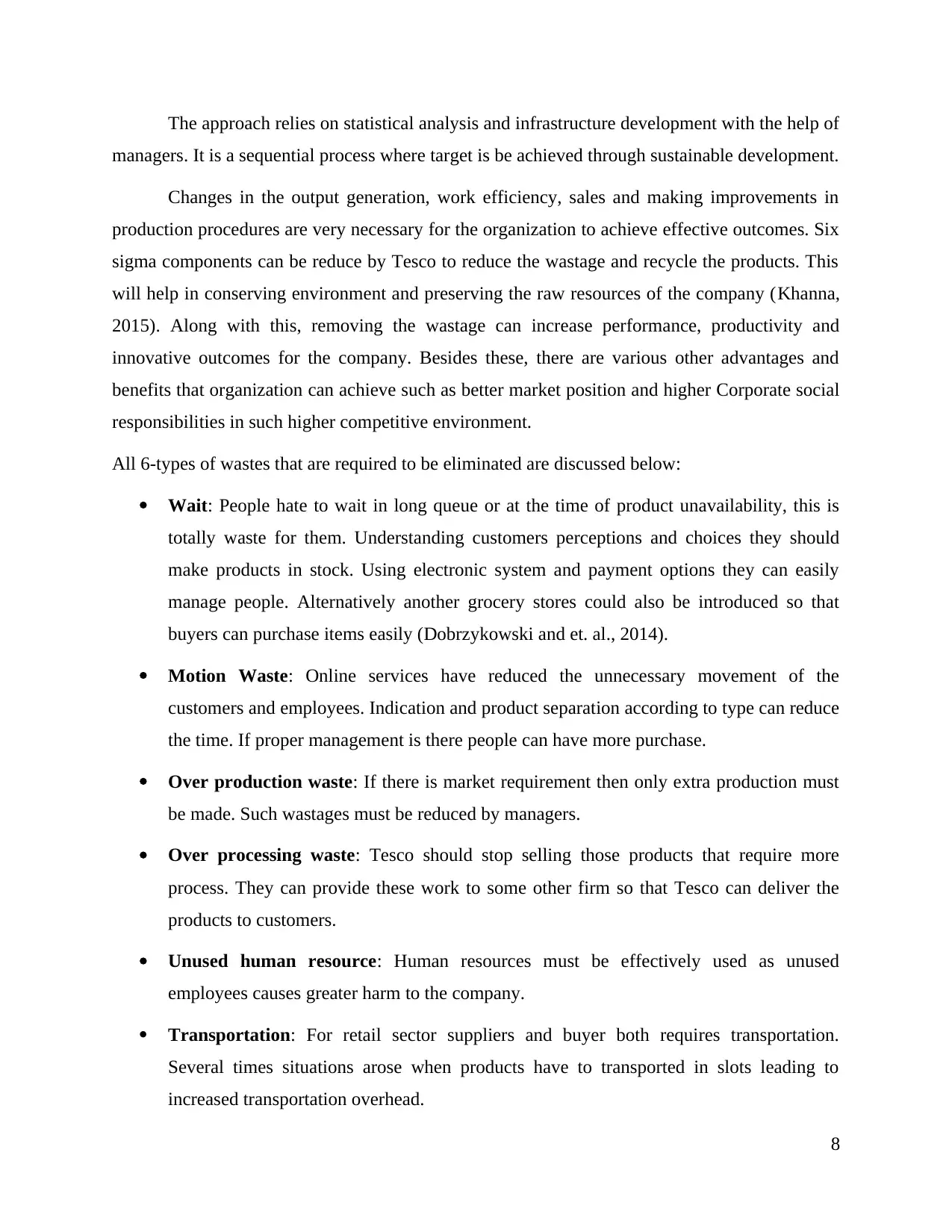
The approach relies on statistical analysis and infrastructure development with the help of
managers. It is a sequential process where target is be achieved through sustainable development.
Changes in the output generation, work efficiency, sales and making improvements in
production procedures are very necessary for the organization to achieve effective outcomes. Six
sigma components can be reduce by Tesco to reduce the wastage and recycle the products. This
will help in conserving environment and preserving the raw resources of the company (Khanna,
2015). Along with this, removing the wastage can increase performance, productivity and
innovative outcomes for the company. Besides these, there are various other advantages and
benefits that organization can achieve such as better market position and higher Corporate social
responsibilities in such higher competitive environment.
All 6-types of wastes that are required to be eliminated are discussed below:
Wait: People hate to wait in long queue or at the time of product unavailability, this is
totally waste for them. Understanding customers perceptions and choices they should
make products in stock. Using electronic system and payment options they can easily
manage people. Alternatively another grocery stores could also be introduced so that
buyers can purchase items easily (Dobrzykowski and et. al., 2014).
Motion Waste: Online services have reduced the unnecessary movement of the
customers and employees. Indication and product separation according to type can reduce
the time. If proper management is there people can have more purchase.
Over production waste: If there is market requirement then only extra production must
be made. Such wastages must be reduced by managers.
Over processing waste: Tesco should stop selling those products that require more
process. They can provide these work to some other firm so that Tesco can deliver the
products to customers.
Unused human resource: Human resources must be effectively used as unused
employees causes greater harm to the company.
Transportation: For retail sector suppliers and buyer both requires transportation.
Several times situations arose when products have to transported in slots leading to
increased transportation overhead.
8
managers. It is a sequential process where target is be achieved through sustainable development.
Changes in the output generation, work efficiency, sales and making improvements in
production procedures are very necessary for the organization to achieve effective outcomes. Six
sigma components can be reduce by Tesco to reduce the wastage and recycle the products. This
will help in conserving environment and preserving the raw resources of the company (Khanna,
2015). Along with this, removing the wastage can increase performance, productivity and
innovative outcomes for the company. Besides these, there are various other advantages and
benefits that organization can achieve such as better market position and higher Corporate social
responsibilities in such higher competitive environment.
All 6-types of wastes that are required to be eliminated are discussed below:
Wait: People hate to wait in long queue or at the time of product unavailability, this is
totally waste for them. Understanding customers perceptions and choices they should
make products in stock. Using electronic system and payment options they can easily
manage people. Alternatively another grocery stores could also be introduced so that
buyers can purchase items easily (Dobrzykowski and et. al., 2014).
Motion Waste: Online services have reduced the unnecessary movement of the
customers and employees. Indication and product separation according to type can reduce
the time. If proper management is there people can have more purchase.
Over production waste: If there is market requirement then only extra production must
be made. Such wastages must be reduced by managers.
Over processing waste: Tesco should stop selling those products that require more
process. They can provide these work to some other firm so that Tesco can deliver the
products to customers.
Unused human resource: Human resources must be effectively used as unused
employees causes greater harm to the company.
Transportation: For retail sector suppliers and buyer both requires transportation.
Several times situations arose when products have to transported in slots leading to
increased transportation overhead.
8
Paraphrase This Document
Need a fresh take? Get an instant paraphrase of this document with our AI Paraphraser
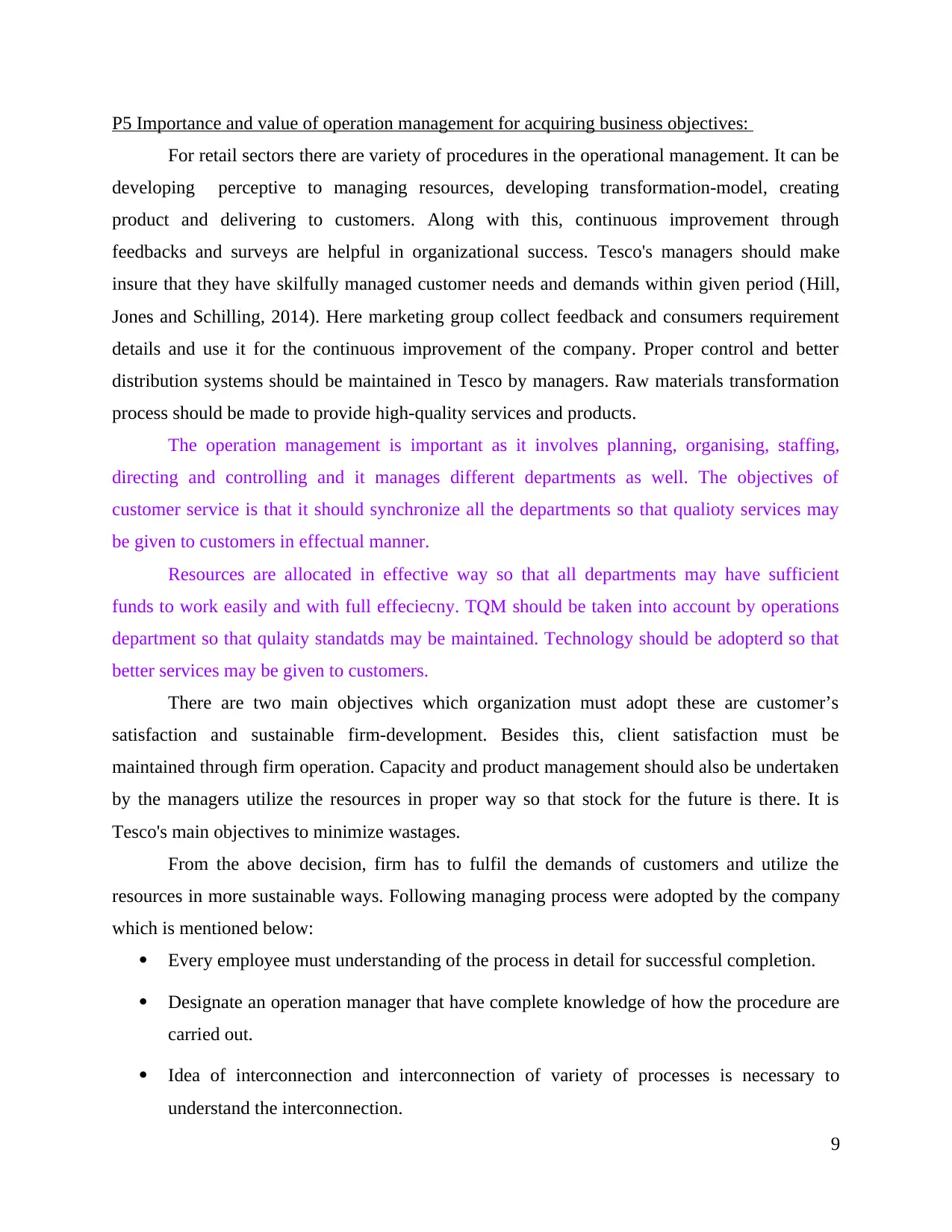
P5 Importance and value of operation management for acquiring business objectives:
For retail sectors there are variety of procedures in the operational management. It can be
developing perceptive to managing resources, developing transformation-model, creating
product and delivering to customers. Along with this, continuous improvement through
feedbacks and surveys are helpful in organizational success. Tesco's managers should make
insure that they have skilfully managed customer needs and demands within given period (Hill,
Jones and Schilling, 2014). Here marketing group collect feedback and consumers requirement
details and use it for the continuous improvement of the company. Proper control and better
distribution systems should be maintained in Tesco by managers. Raw materials transformation
process should be made to provide high-quality services and products.
The operation management is important as it involves planning, organising, staffing,
directing and controlling and it manages different departments as well. The objectives of
customer service is that it should synchronize all the departments so that qualioty services may
be given to customers in effectual manner.
Resources are allocated in effective way so that all departments may have sufficient
funds to work easily and with full effeciecny. TQM should be taken into account by operations
department so that qulaity standatds may be maintained. Technology should be adopterd so that
better services may be given to customers.
There are two main objectives which organization must adopt these are customer’s
satisfaction and sustainable firm-development. Besides this, client satisfaction must be
maintained through firm operation. Capacity and product management should also be undertaken
by the managers utilize the resources in proper way so that stock for the future is there. It is
Tesco's main objectives to minimize wastages.
From the above decision, firm has to fulfil the demands of customers and utilize the
resources in more sustainable ways. Following managing process were adopted by the company
which is mentioned below:
Every employee must understanding of the process in detail for successful completion.
Designate an operation manager that have complete knowledge of how the procedure are
carried out.
Idea of interconnection and interconnection of variety of processes is necessary to
understand the interconnection.
9
For retail sectors there are variety of procedures in the operational management. It can be
developing perceptive to managing resources, developing transformation-model, creating
product and delivering to customers. Along with this, continuous improvement through
feedbacks and surveys are helpful in organizational success. Tesco's managers should make
insure that they have skilfully managed customer needs and demands within given period (Hill,
Jones and Schilling, 2014). Here marketing group collect feedback and consumers requirement
details and use it for the continuous improvement of the company. Proper control and better
distribution systems should be maintained in Tesco by managers. Raw materials transformation
process should be made to provide high-quality services and products.
The operation management is important as it involves planning, organising, staffing,
directing and controlling and it manages different departments as well. The objectives of
customer service is that it should synchronize all the departments so that qualioty services may
be given to customers in effectual manner.
Resources are allocated in effective way so that all departments may have sufficient
funds to work easily and with full effeciecny. TQM should be taken into account by operations
department so that qulaity standatds may be maintained. Technology should be adopterd so that
better services may be given to customers.
There are two main objectives which organization must adopt these are customer’s
satisfaction and sustainable firm-development. Besides this, client satisfaction must be
maintained through firm operation. Capacity and product management should also be undertaken
by the managers utilize the resources in proper way so that stock for the future is there. It is
Tesco's main objectives to minimize wastages.
From the above decision, firm has to fulfil the demands of customers and utilize the
resources in more sustainable ways. Following managing process were adopted by the company
which is mentioned below:
Every employee must understanding of the process in detail for successful completion.
Designate an operation manager that have complete knowledge of how the procedure are
carried out.
Idea of interconnection and interconnection of variety of processes is necessary to
understand the interconnection.
9
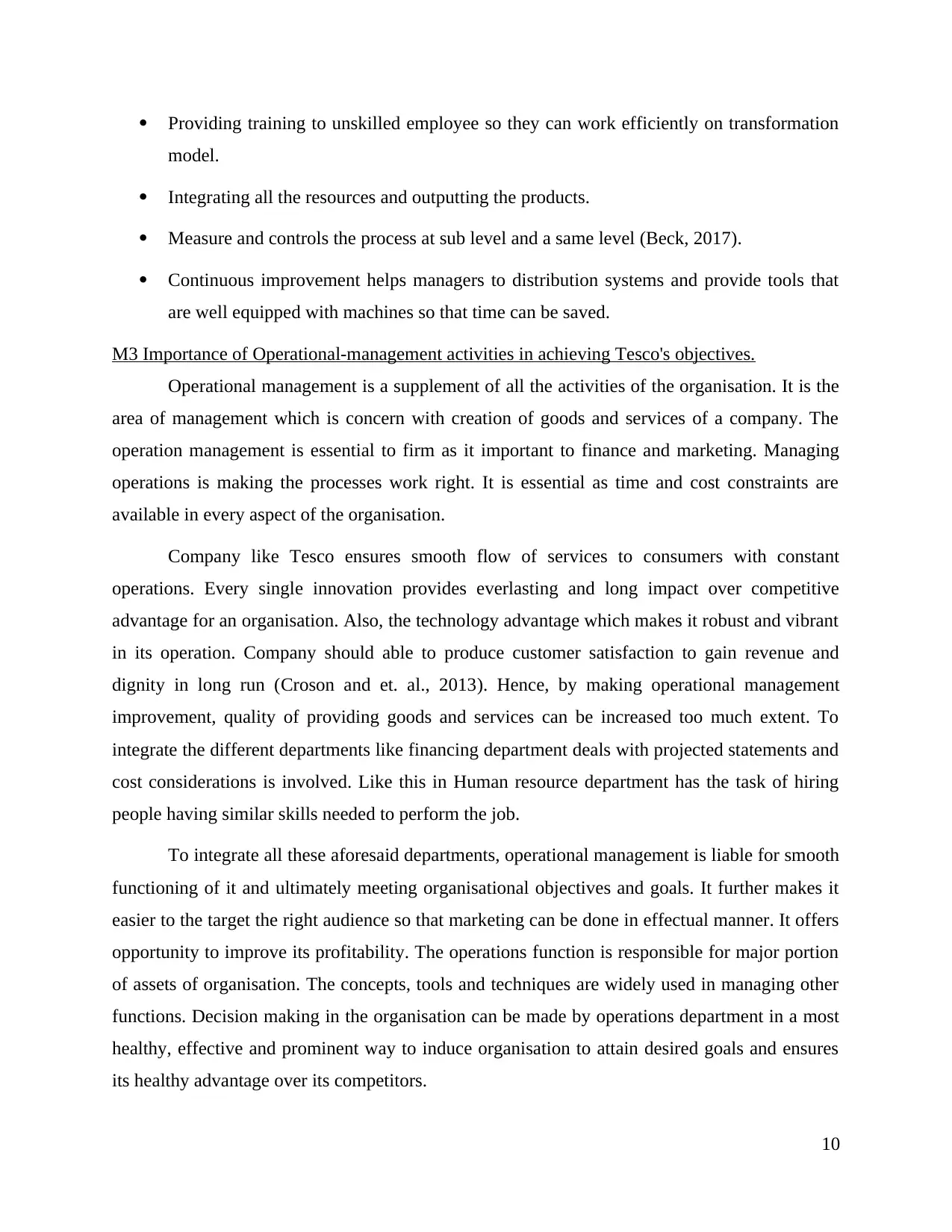
Providing training to unskilled employee so they can work efficiently on transformation
model.
Integrating all the resources and outputting the products.
Measure and controls the process at sub level and a same level (Beck, 2017).
Continuous improvement helps managers to distribution systems and provide tools that
are well equipped with machines so that time can be saved.
M3 Importance of Operational-management activities in achieving Tesco's objectives.
Operational management is a supplement of all the activities of the organisation. It is the
area of management which is concern with creation of goods and services of a company. The
operation management is essential to firm as it important to finance and marketing. Managing
operations is making the processes work right. It is essential as time and cost constraints are
available in every aspect of the organisation.
Company like Tesco ensures smooth flow of services to consumers with constant
operations. Every single innovation provides everlasting and long impact over competitive
advantage for an organisation. Also, the technology advantage which makes it robust and vibrant
in its operation. Company should able to produce customer satisfaction to gain revenue and
dignity in long run (Croson and et. al., 2013). Hence, by making operational management
improvement, quality of providing goods and services can be increased too much extent. To
integrate the different departments like financing department deals with projected statements and
cost considerations is involved. Like this in Human resource department has the task of hiring
people having similar skills needed to perform the job.
To integrate all these aforesaid departments, operational management is liable for smooth
functioning of it and ultimately meeting organisational objectives and goals. It further makes it
easier to the target the right audience so that marketing can be done in effectual manner. It offers
opportunity to improve its profitability. The operations function is responsible for major portion
of assets of organisation. The concepts, tools and techniques are widely used in managing other
functions. Decision making in the organisation can be made by operations department in a most
healthy, effective and prominent way to induce organisation to attain desired goals and ensures
its healthy advantage over its competitors.
10
model.
Integrating all the resources and outputting the products.
Measure and controls the process at sub level and a same level (Beck, 2017).
Continuous improvement helps managers to distribution systems and provide tools that
are well equipped with machines so that time can be saved.
M3 Importance of Operational-management activities in achieving Tesco's objectives.
Operational management is a supplement of all the activities of the organisation. It is the
area of management which is concern with creation of goods and services of a company. The
operation management is essential to firm as it important to finance and marketing. Managing
operations is making the processes work right. It is essential as time and cost constraints are
available in every aspect of the organisation.
Company like Tesco ensures smooth flow of services to consumers with constant
operations. Every single innovation provides everlasting and long impact over competitive
advantage for an organisation. Also, the technology advantage which makes it robust and vibrant
in its operation. Company should able to produce customer satisfaction to gain revenue and
dignity in long run (Croson and et. al., 2013). Hence, by making operational management
improvement, quality of providing goods and services can be increased too much extent. To
integrate the different departments like financing department deals with projected statements and
cost considerations is involved. Like this in Human resource department has the task of hiring
people having similar skills needed to perform the job.
To integrate all these aforesaid departments, operational management is liable for smooth
functioning of it and ultimately meeting organisational objectives and goals. It further makes it
easier to the target the right audience so that marketing can be done in effectual manner. It offers
opportunity to improve its profitability. The operations function is responsible for major portion
of assets of organisation. The concepts, tools and techniques are widely used in managing other
functions. Decision making in the organisation can be made by operations department in a most
healthy, effective and prominent way to induce organisation to attain desired goals and ensures
its healthy advantage over its competitors.
10
⊘ This is a preview!⊘
Do you want full access?
Subscribe today to unlock all pages.

Trusted by 1+ million students worldwide
1 out of 18
Related Documents
Your All-in-One AI-Powered Toolkit for Academic Success.
+13062052269
info@desklib.com
Available 24*7 on WhatsApp / Email
![[object Object]](/_next/static/media/star-bottom.7253800d.svg)
Unlock your academic potential
Copyright © 2020–2025 A2Z Services. All Rights Reserved. Developed and managed by ZUCOL.




